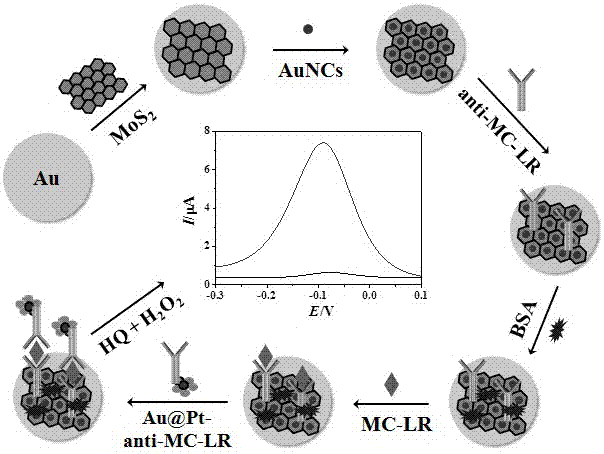Electrochemical method for detecting microcystic toxins
A microcystin, electrochemical technology, applied in the field of analytical chemistry or water environment monitoring, can solve the problems of inability to identify toxins, false positive reactions, etc., and achieves low-cost instruments and equipment, simple and easy methods, and excellent electrical conductivity. Effect
- Summary
- Abstract
- Description
- Claims
- Application Information
AI Technical Summary
Problems solved by technology
Method used
Image
Examples
Embodiment 1
[0034] Flake MoS 2 Preparation of nanomaterials:
[0035] Preparation of MoS by hydrothermal method 2 , weighed 90 mg of sodium molybdate and 180 mg of thioacetamide in 60 mL of distilled water, added 0.5 mL of 1 M NaOH to adjust the solution to be alkaline, transferred to a 100 mL reaction kettle, and reacted hydrothermally at 220 °C for 48 h, cooled to room temperature, washed with deionized water and ethanol several times, the precipitate was collected by centrifugation, and dried in vacuum at 80 °C for 12 h to obtain MoS 2 Nanomaterials, stored for later use.
Embodiment 2
[0037] Preparation of AuNCs:
[0038] The bovine serum albumin-mediated method was used to synthesize AuNCs. The synthesis process was mild and non-toxic, and the quantum yield of the product was greatly improved. The glass instruments required for the synthesis were first soaked in aqua regia, washed with deionized water, and dried for later use. 10 mL of 5 mM HAuCl at 37°C 4 Mix with 5 mL of 50 mg / mL bovine serum albumin (BSA), stir for 5 minutes, BSA interacts with chloroauric acid ions, coat the chloroauric acid ions inside the protein, and then add 0.5 mL of 1 M NaOH to adjust the solution to be Basic, enhances the reducing ability of amino acid residues in BSA. The reaction was stirred at 37°C for 12 h, and the chloroauric acid was reduced to obtain a red fluorescent AuNCs solution, which was stored for future use.
example 3
[0040] Preparation of Au@Pt core-shell nanomaterials:
[0041] Au@Pt core-shell nanomaterials were prepared by seed growth method. First, a seed solution of gold nanoparticles (AuNPs) with a particle size of 19 nm was prepared by the sodium citrate reduction method. Afterwards, a certain amount of AuNPs seed solution was mixed with 10 mL of 1 mM H 2 PtCl 6 The solution was stirred in a 100 mL round bottom flask. In a constant temperature oil bath at 80 °C, 5 mL of 10 mM ascorbic acid solution was slowly added dropwise (10 drops / min), and refluxed at a constant temperature of 80 °C for 30 min to obtain Au@Pt core-shell nanomaterials.
PUM
| Property | Measurement | Unit |
|---|---|---|
| diameter | aaaaa | aaaaa |
| particle diameter | aaaaa | aaaaa |
Abstract
Description
Claims
Application Information
 Login to View More
Login to View More - R&D
- Intellectual Property
- Life Sciences
- Materials
- Tech Scout
- Unparalleled Data Quality
- Higher Quality Content
- 60% Fewer Hallucinations
Browse by: Latest US Patents, China's latest patents, Technical Efficacy Thesaurus, Application Domain, Technology Topic, Popular Technical Reports.
© 2025 PatSnap. All rights reserved.Legal|Privacy policy|Modern Slavery Act Transparency Statement|Sitemap|About US| Contact US: help@patsnap.com


